Comprehensive Report: Best Practices for Relational Database Modeling
VerifiedAdded on 2023/06/04
|5
|1702
|443
Report
AI Summary
This report provides a comprehensive overview of best practices for relational database modeling. It begins with an introduction to the relational model, emphasizing its structure and declarative approach for specifying data and queries. The report then details key best practices, including consistent naming conventions, proper use of data types, and the importance of data integrity through constraints. It covers aspects like security (password encryption), performance optimization (indexing, partitioning), and the avoidance of common pitfalls such as over-normalization. The report also highlights the significance of database documentation and the placement of database and web servers on separate machines. The conclusion emphasizes the role of SQL and relational operations in data retrieval and manipulation. References to relevant research papers are included to support the discussed practices and concepts.
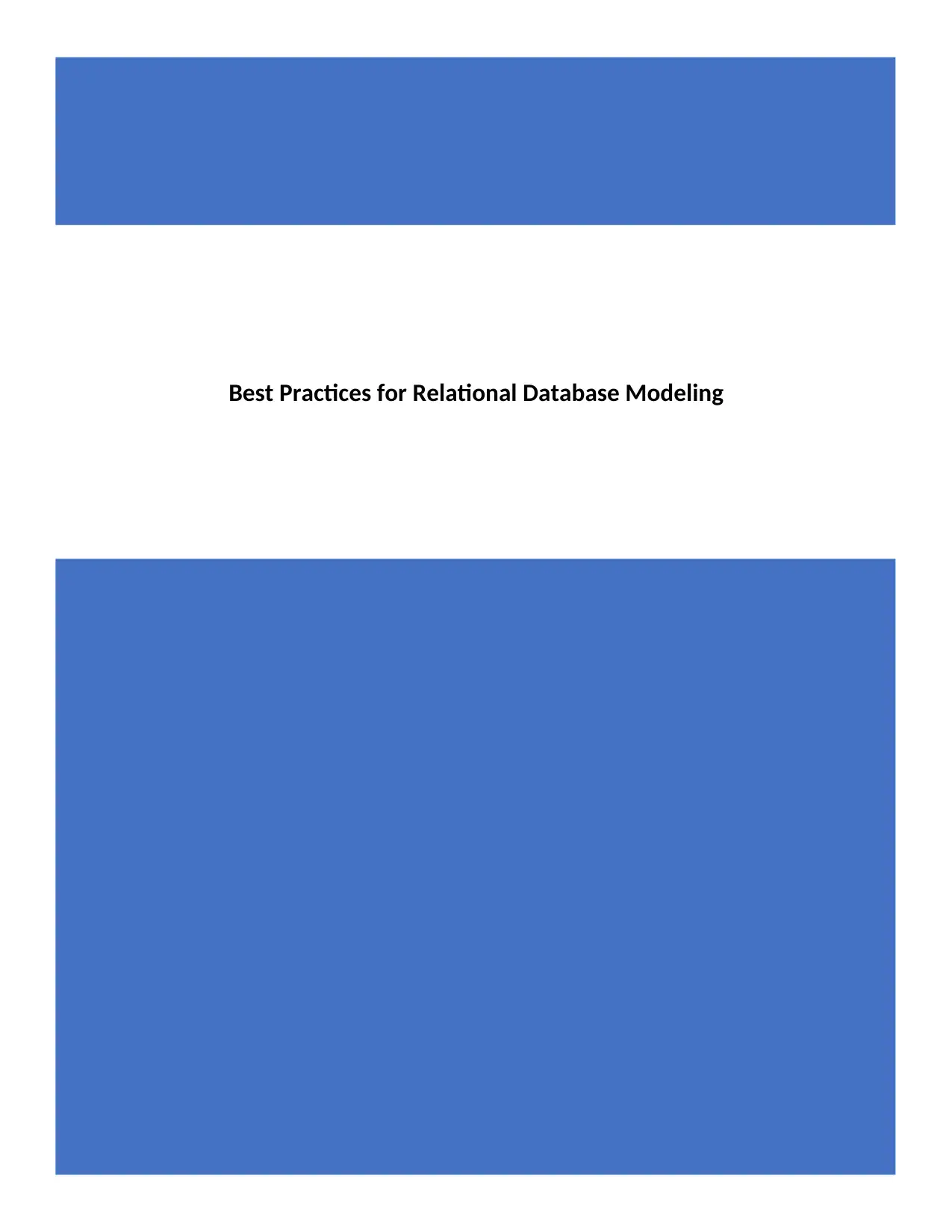
Best Practices for Relational Database Modeling
Paraphrase This Document
Need a fresh take? Get an instant paraphrase of this document with our AI Paraphraser
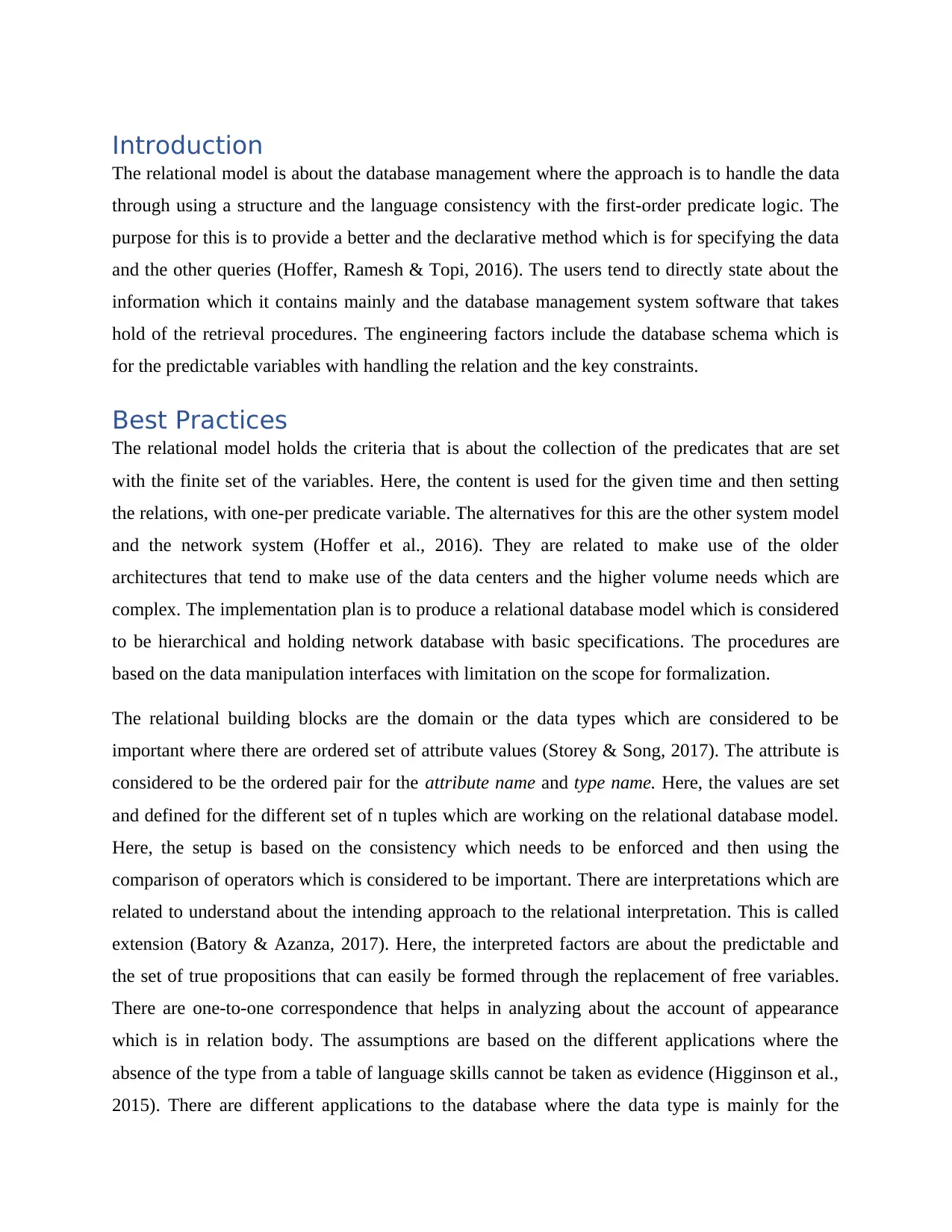
Introduction
The relational model is about the database management where the approach is to handle the data
through using a structure and the language consistency with the first-order predicate logic. The
purpose for this is to provide a better and the declarative method which is for specifying the data
and the other queries (Hoffer, Ramesh & Topi, 2016). The users tend to directly state about the
information which it contains mainly and the database management system software that takes
hold of the retrieval procedures. The engineering factors include the database schema which is
for the predictable variables with handling the relation and the key constraints.
Best Practices
The relational model holds the criteria that is about the collection of the predicates that are set
with the finite set of the variables. Here, the content is used for the given time and then setting
the relations, with one-per predicate variable. The alternatives for this are the other system model
and the network system (Hoffer et al., 2016). They are related to make use of the older
architectures that tend to make use of the data centers and the higher volume needs which are
complex. The implementation plan is to produce a relational database model which is considered
to be hierarchical and holding network database with basic specifications. The procedures are
based on the data manipulation interfaces with limitation on the scope for formalization.
The relational building blocks are the domain or the data types which are considered to be
important where there are ordered set of attribute values (Storey & Song, 2017). The attribute is
considered to be the ordered pair for the attribute name and type name. Here, the values are set
and defined for the different set of n tuples which are working on the relational database model.
Here, the setup is based on the consistency which needs to be enforced and then using the
comparison of operators which is considered to be important. There are interpretations which are
related to understand about the intending approach to the relational interpretation. This is called
extension (Batory & Azanza, 2017). Here, the interpreted factors are about the predictable and
the set of true propositions that can easily be formed through the replacement of free variables.
There are one-to-one correspondence that helps in analyzing about the account of appearance
which is in relation body. The assumptions are based on the different applications where the
absence of the type from a table of language skills cannot be taken as evidence (Higginson et al.,
2015). There are different applications to the database where the data type is mainly for the
The relational model is about the database management where the approach is to handle the data
through using a structure and the language consistency with the first-order predicate logic. The
purpose for this is to provide a better and the declarative method which is for specifying the data
and the other queries (Hoffer, Ramesh & Topi, 2016). The users tend to directly state about the
information which it contains mainly and the database management system software that takes
hold of the retrieval procedures. The engineering factors include the database schema which is
for the predictable variables with handling the relation and the key constraints.
Best Practices
The relational model holds the criteria that is about the collection of the predicates that are set
with the finite set of the variables. Here, the content is used for the given time and then setting
the relations, with one-per predicate variable. The alternatives for this are the other system model
and the network system (Hoffer et al., 2016). They are related to make use of the older
architectures that tend to make use of the data centers and the higher volume needs which are
complex. The implementation plan is to produce a relational database model which is considered
to be hierarchical and holding network database with basic specifications. The procedures are
based on the data manipulation interfaces with limitation on the scope for formalization.
The relational building blocks are the domain or the data types which are considered to be
important where there are ordered set of attribute values (Storey & Song, 2017). The attribute is
considered to be the ordered pair for the attribute name and type name. Here, the values are set
and defined for the different set of n tuples which are working on the relational database model.
Here, the setup is based on the consistency which needs to be enforced and then using the
comparison of operators which is considered to be important. There are interpretations which are
related to understand about the intending approach to the relational interpretation. This is called
extension (Batory & Azanza, 2017). Here, the interpreted factors are about the predictable and
the set of true propositions that can easily be formed through the replacement of free variables.
There are one-to-one correspondence that helps in analyzing about the account of appearance
which is in relation body. The assumptions are based on the different applications where the
absence of the type from a table of language skills cannot be taken as evidence (Higginson et al.,
2015). There are different applications to the database where the data type is mainly for the
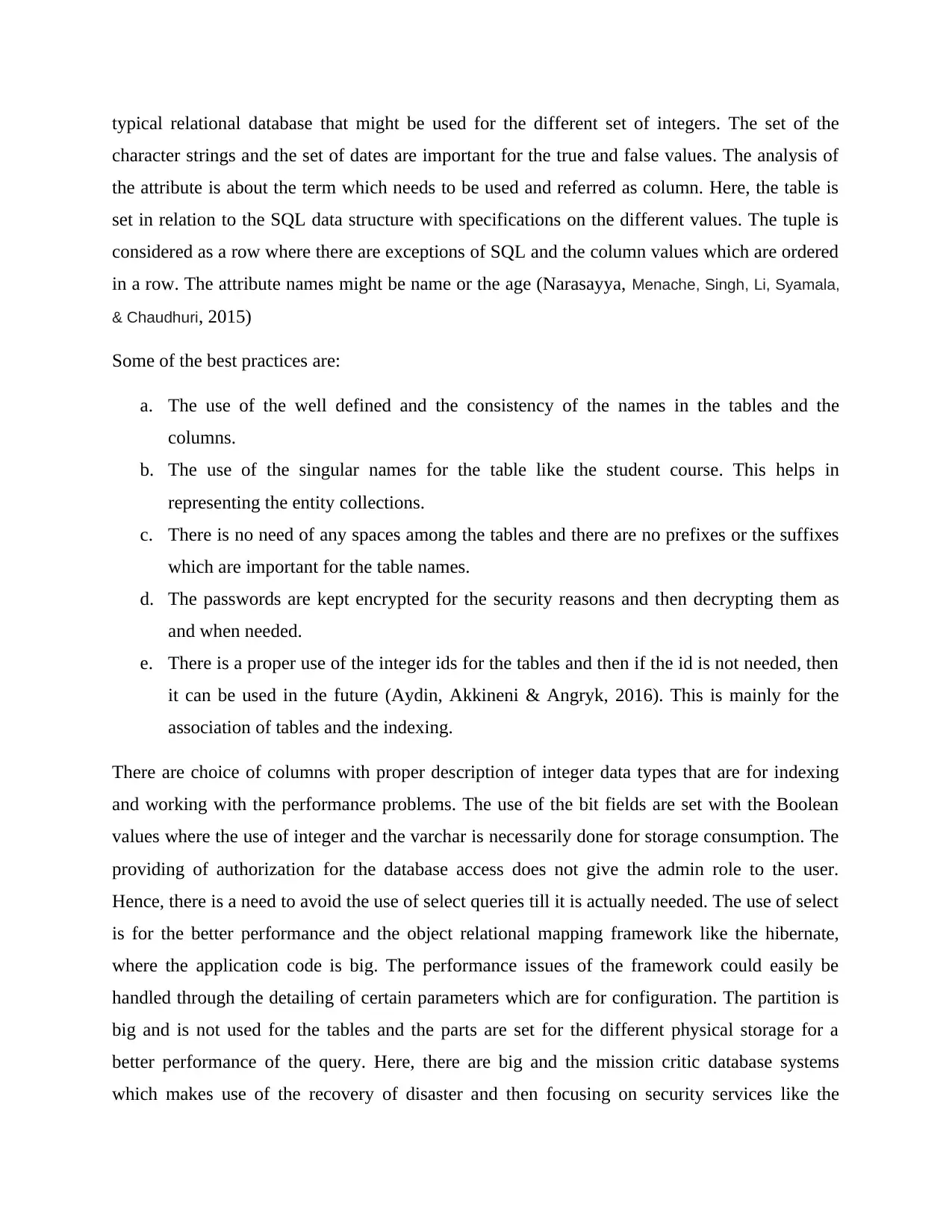
typical relational database that might be used for the different set of integers. The set of the
character strings and the set of dates are important for the true and false values. The analysis of
the attribute is about the term which needs to be used and referred as column. Here, the table is
set in relation to the SQL data structure with specifications on the different values. The tuple is
considered as a row where there are exceptions of SQL and the column values which are ordered
in a row. The attribute names might be name or the age (Narasayya, Menache, Singh, Li, Syamala,
& Chaudhuri, 2015)
Some of the best practices are:
a. The use of the well defined and the consistency of the names in the tables and the
columns.
b. The use of the singular names for the table like the student course. This helps in
representing the entity collections.
c. There is no need of any spaces among the tables and there are no prefixes or the suffixes
which are important for the table names.
d. The passwords are kept encrypted for the security reasons and then decrypting them as
and when needed.
e. There is a proper use of the integer ids for the tables and then if the id is not needed, then
it can be used in the future (Aydin, Akkineni & Angryk, 2016). This is mainly for the
association of tables and the indexing.
There are choice of columns with proper description of integer data types that are for indexing
and working with the performance problems. The use of the bit fields are set with the Boolean
values where the use of integer and the varchar is necessarily done for storage consumption. The
providing of authorization for the database access does not give the admin role to the user.
Hence, there is a need to avoid the use of select queries till it is actually needed. The use of select
is for the better performance and the object relational mapping framework like the hibernate,
where the application code is big. The performance issues of the framework could easily be
handled through the detailing of certain parameters which are for configuration. The partition is
big and is not used for the tables and the parts are set for the different physical storage for a
better performance of the query. Here, there are big and the mission critic database systems
which makes use of the recovery of disaster and then focusing on security services like the
character strings and the set of dates are important for the true and false values. The analysis of
the attribute is about the term which needs to be used and referred as column. Here, the table is
set in relation to the SQL data structure with specifications on the different values. The tuple is
considered as a row where there are exceptions of SQL and the column values which are ordered
in a row. The attribute names might be name or the age (Narasayya, Menache, Singh, Li, Syamala,
& Chaudhuri, 2015)
Some of the best practices are:
a. The use of the well defined and the consistency of the names in the tables and the
columns.
b. The use of the singular names for the table like the student course. This helps in
representing the entity collections.
c. There is no need of any spaces among the tables and there are no prefixes or the suffixes
which are important for the table names.
d. The passwords are kept encrypted for the security reasons and then decrypting them as
and when needed.
e. There is a proper use of the integer ids for the tables and then if the id is not needed, then
it can be used in the future (Aydin, Akkineni & Angryk, 2016). This is mainly for the
association of tables and the indexing.
There are choice of columns with proper description of integer data types that are for indexing
and working with the performance problems. The use of the bit fields are set with the Boolean
values where the use of integer and the varchar is necessarily done for storage consumption. The
providing of authorization for the database access does not give the admin role to the user.
Hence, there is a need to avoid the use of select queries till it is actually needed. The use of select
is for the better performance and the object relational mapping framework like the hibernate,
where the application code is big. The performance issues of the framework could easily be
handled through the detailing of certain parameters which are for configuration. The partition is
big and is not used for the tables and the parts are set for the different physical storage for a
better performance of the query. Here, there are big and the mission critic database systems
which makes use of the recovery of disaster and then focusing on security services like the
⊘ This is a preview!⊘
Do you want full access?
Subscribe today to unlock all pages.

Trusted by 1+ million students worldwide
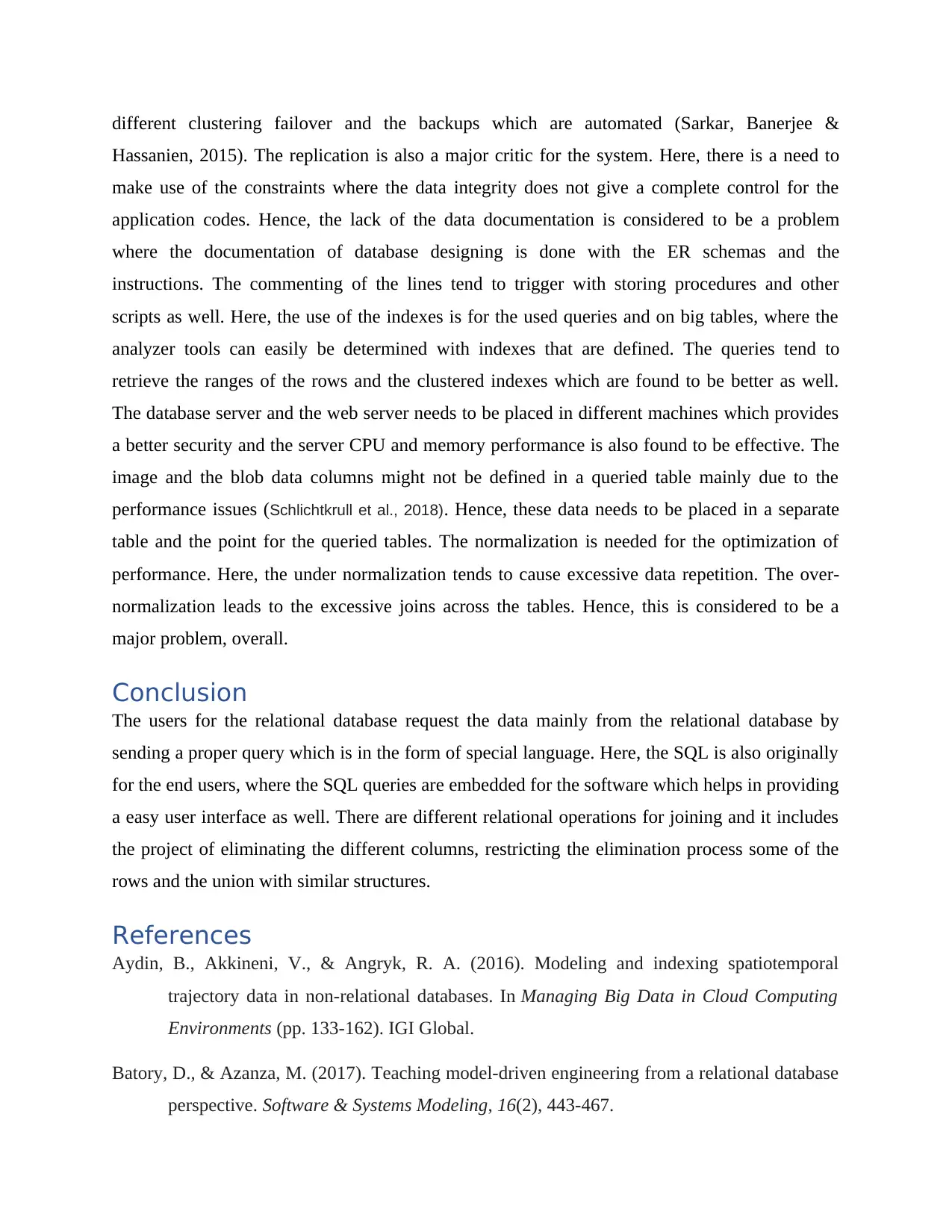
different clustering failover and the backups which are automated (Sarkar, Banerjee &
Hassanien, 2015). The replication is also a major critic for the system. Here, there is a need to
make use of the constraints where the data integrity does not give a complete control for the
application codes. Hence, the lack of the data documentation is considered to be a problem
where the documentation of database designing is done with the ER schemas and the
instructions. The commenting of the lines tend to trigger with storing procedures and other
scripts as well. Here, the use of the indexes is for the used queries and on big tables, where the
analyzer tools can easily be determined with indexes that are defined. The queries tend to
retrieve the ranges of the rows and the clustered indexes which are found to be better as well.
The database server and the web server needs to be placed in different machines which provides
a better security and the server CPU and memory performance is also found to be effective. The
image and the blob data columns might not be defined in a queried table mainly due to the
performance issues (Schlichtkrull et al., 2018). Hence, these data needs to be placed in a separate
table and the point for the queried tables. The normalization is needed for the optimization of
performance. Here, the under normalization tends to cause excessive data repetition. The over-
normalization leads to the excessive joins across the tables. Hence, this is considered to be a
major problem, overall.
Conclusion
The users for the relational database request the data mainly from the relational database by
sending a proper query which is in the form of special language. Here, the SQL is also originally
for the end users, where the SQL queries are embedded for the software which helps in providing
a easy user interface as well. There are different relational operations for joining and it includes
the project of eliminating the different columns, restricting the elimination process some of the
rows and the union with similar structures.
References
Aydin, B., Akkineni, V., & Angryk, R. A. (2016). Modeling and indexing spatiotemporal
trajectory data in non-relational databases. In Managing Big Data in Cloud Computing
Environments (pp. 133-162). IGI Global.
Batory, D., & Azanza, M. (2017). Teaching model-driven engineering from a relational database
perspective. Software & Systems Modeling, 16(2), 443-467.
Hassanien, 2015). The replication is also a major critic for the system. Here, there is a need to
make use of the constraints where the data integrity does not give a complete control for the
application codes. Hence, the lack of the data documentation is considered to be a problem
where the documentation of database designing is done with the ER schemas and the
instructions. The commenting of the lines tend to trigger with storing procedures and other
scripts as well. Here, the use of the indexes is for the used queries and on big tables, where the
analyzer tools can easily be determined with indexes that are defined. The queries tend to
retrieve the ranges of the rows and the clustered indexes which are found to be better as well.
The database server and the web server needs to be placed in different machines which provides
a better security and the server CPU and memory performance is also found to be effective. The
image and the blob data columns might not be defined in a queried table mainly due to the
performance issues (Schlichtkrull et al., 2018). Hence, these data needs to be placed in a separate
table and the point for the queried tables. The normalization is needed for the optimization of
performance. Here, the under normalization tends to cause excessive data repetition. The over-
normalization leads to the excessive joins across the tables. Hence, this is considered to be a
major problem, overall.
Conclusion
The users for the relational database request the data mainly from the relational database by
sending a proper query which is in the form of special language. Here, the SQL is also originally
for the end users, where the SQL queries are embedded for the software which helps in providing
a easy user interface as well. There are different relational operations for joining and it includes
the project of eliminating the different columns, restricting the elimination process some of the
rows and the union with similar structures.
References
Aydin, B., Akkineni, V., & Angryk, R. A. (2016). Modeling and indexing spatiotemporal
trajectory data in non-relational databases. In Managing Big Data in Cloud Computing
Environments (pp. 133-162). IGI Global.
Batory, D., & Azanza, M. (2017). Teaching model-driven engineering from a relational database
perspective. Software & Systems Modeling, 16(2), 443-467.
Paraphrase This Document
Need a fresh take? Get an instant paraphrase of this document with our AI Paraphraser
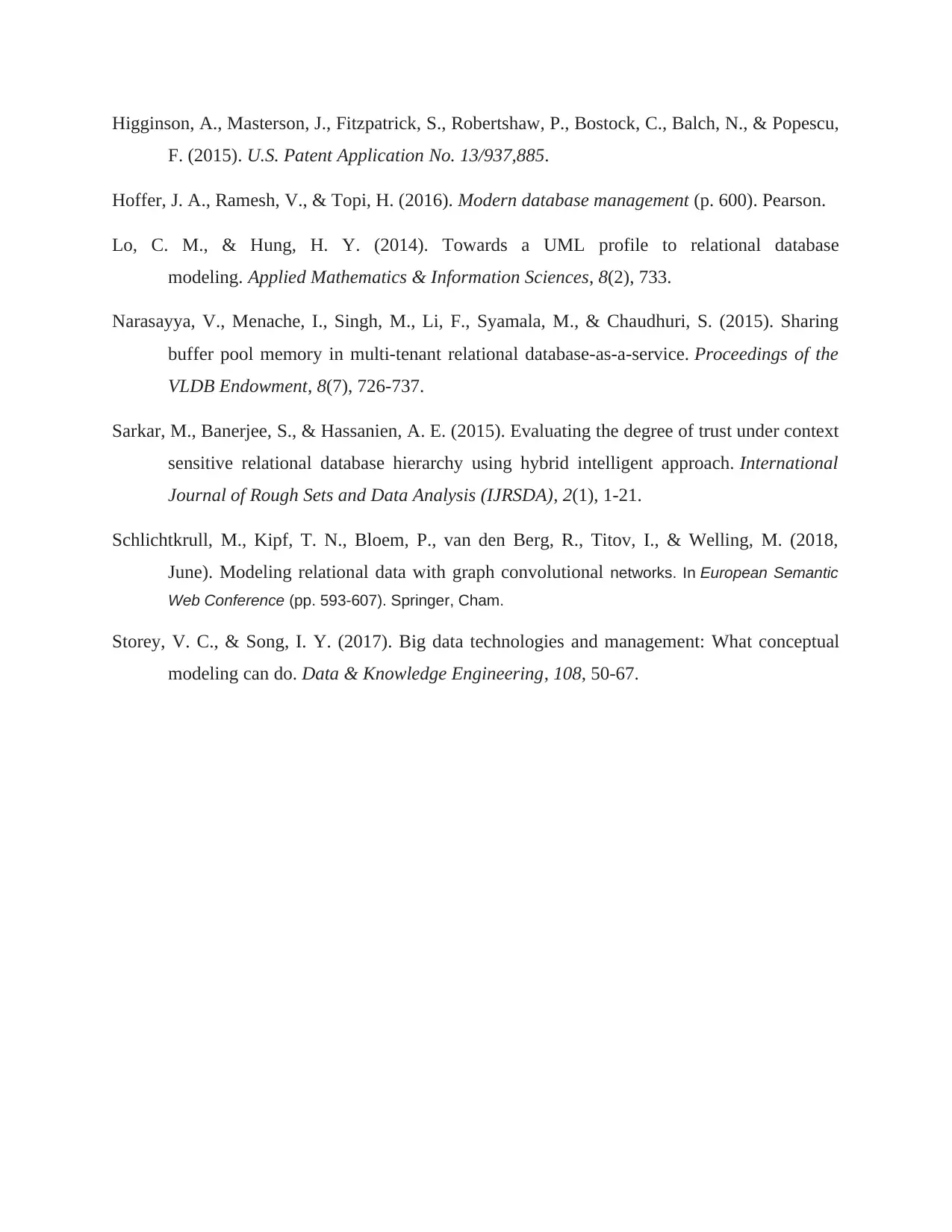
Higginson, A., Masterson, J., Fitzpatrick, S., Robertshaw, P., Bostock, C., Balch, N., & Popescu,
F. (2015). U.S. Patent Application No. 13/937,885.
Hoffer, J. A., Ramesh, V., & Topi, H. (2016). Modern database management (p. 600). Pearson.
Lo, C. M., & Hung, H. Y. (2014). Towards a UML profile to relational database
modeling. Applied Mathematics & Information Sciences, 8(2), 733.
Narasayya, V., Menache, I., Singh, M., Li, F., Syamala, M., & Chaudhuri, S. (2015). Sharing
buffer pool memory in multi-tenant relational database-as-a-service. Proceedings of the
VLDB Endowment, 8(7), 726-737.
Sarkar, M., Banerjee, S., & Hassanien, A. E. (2015). Evaluating the degree of trust under context
sensitive relational database hierarchy using hybrid intelligent approach. International
Journal of Rough Sets and Data Analysis (IJRSDA), 2(1), 1-21.
Schlichtkrull, M., Kipf, T. N., Bloem, P., van den Berg, R., Titov, I., & Welling, M. (2018,
June). Modeling relational data with graph convolutional networks. In European Semantic
Web Conference (pp. 593-607). Springer, Cham.
Storey, V. C., & Song, I. Y. (2017). Big data technologies and management: What conceptual
modeling can do. Data & Knowledge Engineering, 108, 50-67.
F. (2015). U.S. Patent Application No. 13/937,885.
Hoffer, J. A., Ramesh, V., & Topi, H. (2016). Modern database management (p. 600). Pearson.
Lo, C. M., & Hung, H. Y. (2014). Towards a UML profile to relational database
modeling. Applied Mathematics & Information Sciences, 8(2), 733.
Narasayya, V., Menache, I., Singh, M., Li, F., Syamala, M., & Chaudhuri, S. (2015). Sharing
buffer pool memory in multi-tenant relational database-as-a-service. Proceedings of the
VLDB Endowment, 8(7), 726-737.
Sarkar, M., Banerjee, S., & Hassanien, A. E. (2015). Evaluating the degree of trust under context
sensitive relational database hierarchy using hybrid intelligent approach. International
Journal of Rough Sets and Data Analysis (IJRSDA), 2(1), 1-21.
Schlichtkrull, M., Kipf, T. N., Bloem, P., van den Berg, R., Titov, I., & Welling, M. (2018,
June). Modeling relational data with graph convolutional networks. In European Semantic
Web Conference (pp. 593-607). Springer, Cham.
Storey, V. C., & Song, I. Y. (2017). Big data technologies and management: What conceptual
modeling can do. Data & Knowledge Engineering, 108, 50-67.
1 out of 5
Related Documents
Your All-in-One AI-Powered Toolkit for Academic Success.
+13062052269
info@desklib.com
Available 24*7 on WhatsApp / Email
![[object Object]](/_next/static/media/star-bottom.7253800d.svg)
Unlock your academic potential
Copyright © 2020–2025 A2Z Services. All Rights Reserved. Developed and managed by ZUCOL.





